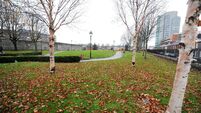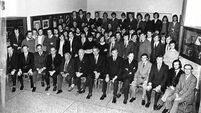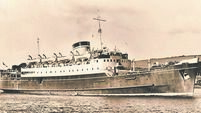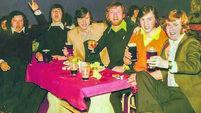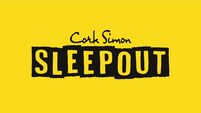Can you solve the mystery surrounding an old Cork city photo?

An old photo of Cathedral Road in Cork city, supplied by reader Martin Humphreys. Can you tell us more about it?
WE have had an interesting picture sent in by Martin Humphreys, in the hope that other readers may be able to identify the occasion.
“I am originally from Cathedral Road but now living in East Cork these past years,” writes Martin, in our weekly Throwback Thursday column.
“I am sending you this photograph that was in my father’s possession for a long time. When he passed on, 37 years ago, it came to me.
“Your readers might be able to enlighten me about this picture and the event it commemorates.
“I am old enough to remember Bishop Coughlan’s statue facing up towards the infant Cathedral Road. New houses are being built, and St Mary’s Hall is on the right, which is now a GP surgery.
“Maybe the readers of Throwback Thursday might know the year this picture was taken and what the occasion was.”
Matin adds, in relation to recent columns: “On a happy note, like some of your readers, I too was a student of your wonderful father, Joey Kerrigan, from 1969 to 1971.
“Joey taught me for science and English class at scoil Stiofain Naofa on Parnell place. He was a very precise man in the way he taught. He wore a tweed jacket with leather elbow patches, and always walked with a purposeful pace.
“I had the pleasure of once winning a writing competition in class. The prize was to be taken on a trip to Lough Guitane and Mangerton mountain in Kerry.
"As a result, all my life to the current day I still hillwalk and lead an active outdoor life.
“Well done, Joey Kerrigan, a mentor of mine! And thank you, Jo, for your wonderful column in the Echo.”
Well that is very nice to hear, Martin. I myself owe my lifelong love of the wild open spaces to my father’s early training. Never a weekend did we spend at home when there was a mountain to be climbed, or a valley to be explored.
And speaking of old pictures requiring some identification, we are still getting great information on that one of s group dating from around 1936 and the probable reopening of the City Hall, sent in by Martin Byrne.
Dick Kenny recognised several people: “My father, Michael Kenny, is in the old IRA photograph in Throwback Thursday’s article of March 2, and I can also name a few more.
“They are: back row, standing: second from left, Pa McGrath, Michael Kenny, Gus Healy with bowtie. Ninth from left is Michael Baylor, eleventh from left Jim Barry with bowtie. Extreme right, Florence O’Donoghue. Back Row sitting: second from left, Hugo Flynn, Tom Crofts and Martin Corry. Front row, squatting on the ground extreme right, Tom Barry.”
These men, says Dick, played a prominent role in the early days of life in Cork.
“Pa McGrath was a blacksmith from Blackrock, Fianna Fail TD, and Lord Mayor of Cork between 1952 and 1956.
“Gus Healy was a keen amateur swimmer, Fianna Fail TD, and served as Lord Mayor of Cork 1964 to 1965 and 1975 to 1976.
“Jim Barry was a trainer of the Cork hurling team from 1926 to 1966, winning 13 All-Ireland titles.
“Tom Crofts was a famous old IRA commandant and founder member of the Fianna Fail party.
“Florence O’Donoghue was Adjutant and Director of Intelligence of the First Cork Brigade, and planned and took part in the controversial kidnapping of seven-year old Reginald Brown in Wales.
“Michael Baylor was a keen soccer player and played for Barracton FC. He and his friend Michael Kenny took part in the Dillon’s Cross ambush which gave the British Crown forces the pretext to burn Cork and the old City Hall, of which this photograph, 16 years later, celebrates the reopening.”
Gosh, that’s great detail, Dick. Hope you are taking note of all these names, Martin Byrne, and writing them on the back of the photo!
We also heard on the same topic from Garett Sheehan, including some great family history.
“I read your recent Throwback Thursday with interest, where you were looking to identify people in a photo submitted by Martin Byrne.
“I believe the gentleman standing 4th from the right at the back is my great-grandfather, J.J. (John Joseph) O’Connell, born in Caheragh, West Cork, on August 16, 1892.
“J.J. lived at 54, Sundays Well Road and subsequently at Suncroft in Victoria Cross, and was heavily involved in the War Of Independence and the Civil War. I understand from family he was inseparable from and best friends with two individuals mentioned in the article, Tom Crofts and Pa McGrath.
“I have found some information on J.J. O’Connell from military records and witness statements, but it has proved difficult.
“Family stories tell me he spent much of his time on the run, as I understand he worked in Military Intelligence. What makes it more difficult is he, unfortunately, has the same name as the famous General, J.J. (Ginger) O’Connell. But I do know that he served in ‘C’ Company, 1st Battalion, 1st Cork Brigade, Old I.R.A.
“Tom Croft was his O.C. at one stage of the Battalion and subsequently wrote on his behalf to the Military Pension Board for his pension to be a rank ‘D’ as he had instructed him to take over the running of the 1st Battalion around January, 1921.”
Garett added: “On May 13, 1920, after the shooting of R.I.C. Sergeant Garvey and Constable Harrington the previous night, I understand J.J. O’Connell (one of Terence MacSwiney’s regular bodyguards) and about 17 armed men with rifles, pistols, and bombs guarded MacSwiney in his home in Sundays Well after getting intelligence that he was going to be killed, similar to Tomas MacCurtain’s fate as the previous Lord Mayor Of Cork.
“On June 1, 1920, J.J. O’Connell was involved in commandeering cars from the Universal Motor Company, Cornmarket Street, Cork, along with Christy McSweeney and C Company. These vehicles were used to block roads as part of the attack on the RIC Barracks in Blarney, which was subsequently burnt down to prevent re-occupation after the RIC evacuated.
“I understand, on July 17, 1920, he was part of the hit squad involved in the shooting of the recently appointed Divisional Commissioner, Gerald Bryce-Ferguson Smyth of the British Army & Police in Munster by the IRA at the County Club, South Mall, Cork. This was captured in the brief RTÉ footage on the Youtube documentary of Gerald Bryce Ferguson Smyth´s Execution Co Cork July 17, 1920.
“Again, the following night, J.J. O’Connell, along with members of C Company, guarded Terence McSwiney, who was staying in Doctor John Fitzgerald’s house in Blarney Road, Cork, as they feared reprisal for the killing of Smyth. The reprisal never took place.
“I understand he served a short time in the City Gaol and I know he was subsequently very involved in the fundraising to erect a monument in the yard of the old City Gaol (still standing, now in UCC college grounds) where a number of his comrades died on hunger strike. Eamon de Velara officiated at the occasion in 1938, and J.J. is standing alongside Pa McGrath at the unveiling.
Garett adds: “J.J O’Connell was a strong Fianna Fail supporter after the war and a Cork Sluagh Committee member circa 1938. He was a builder by trade, subsequently becoming a member of the Harbour Commissioners, and was President of the Construction Federation Of Ireland in 1955. He died on April 21, 1972.
“On a side note, his daughter Maud (my grandmother) subsequently became the first lady president of a GAA club in Ireland (Bishopstown GAA).”
Well done you, Garett. Some finely researched family history recorded there. Everybody else, please copy his fine example!
It doesn’t matter what your ancestors did or even if they don’t seem to have done anything - every little detail you can record is valuable to future historians.

And speaking of past history, we have been talking about trains and boats and planes quite a bit over the past while, but I wonder how many readers realise that Cork city was an important boatbuilding centre in the 19th century?
In the 20th, it was all about Ford cars and Dunlop tyres, but look back a further 100 years and you find some great stories.
When Richard Mills and I were researching our last book, Stories From The Sea (O’Brien Press), we found to our delight that we could actually get pictures of one of the old Pike shipyards, still to be seen on the river, opposite the Marina.
The Pike family also ran the City of Cork Steamship Company, and among its most famous crafts was the Cormorant, one of the first to be built almost entirely of iron. She saw service in the Crimean War and was visited by Queen Victoria and Prince Albert at Portsmouth while horses and supplies were being loaded.
“Apparently, the Queen doubted that it could really be made of iron, as claimed, and borrowed her husband’s pocket penknife to scrape the paint from one of the masts to ascertain the truth of the matter. Finding that they were indeed metal and not wood, she immediately ordered that this should be the material used for all future Government ships. You can’t help feeling, though, that as the royal couple were bowingly escorted off the Cormorant, a deck hand rushed forward with a tin of paint...
And no, of course we haven’t forgotten all the boatbuilding that went on all around the Cork coast, at Crosshaven and so many other harbours. Or the shipyard at Passage and the stirring story of the Sirius, commissioned by the Pike family, and the first steamship to cross the Atlantic. She left Passage on April 4, 1838, with Captain Roberts in charge and headed for the open Atlantic with just one determined aim in mind - to get there before the huge English boat, the Great Western.

Wouldn’t you love to have been there that early morning of April 23 as the little Sirius triumphantly sailed up the Hudson to New York, to be met by cheering crowds? The best bit, though, was definitely what ensued as the celebrations got under way, as was reported at the time.:
“Whilst all this was going on, suddenly there was seen over Governor’s Island a dense black cloud of smoke spreading itself upward, and betokening another arrival. On it came with great rapidity, and at about three o’clock in the afternoon its cause was made fully manifest to the accumulated multitudes at the battery.
It was the steam ship Great Western, of about 1,600 tons burden, under the command of Lieutenant Hosken, R.N. She had left Bristol on the7th inst, and on the 23rd was making her triumphant entry into the port of New York.
This immense moving mass was propelled at a rapid rate through the waters of the bay; she passed swiftly and gracefully around the Sirius, exchanging salutes with her, and then proceeded to her destined anchorage in the East River.”
Monmouthshire Merlin, May 26, from New York correspondent. Quoted in Stories from the Sea, O’Brien Press, 2021.
Oh to have been on deck with Captain Roberts, and seen him smile politely, salute courteously, as his rival steamed furiously past…
The Great Western was delayed in starting, but did in fact make very good time. However, the facts could not be denied - the doughty little Sirius had made the first steamship crossing. So there!
Any memories of old shipyards, messing about in boats, or other childhood recollections? Share them with us. Email jokerrigan1@gmail.com or leave a comment on our Facebook page: https://www.facebook.com/echolivecork.
